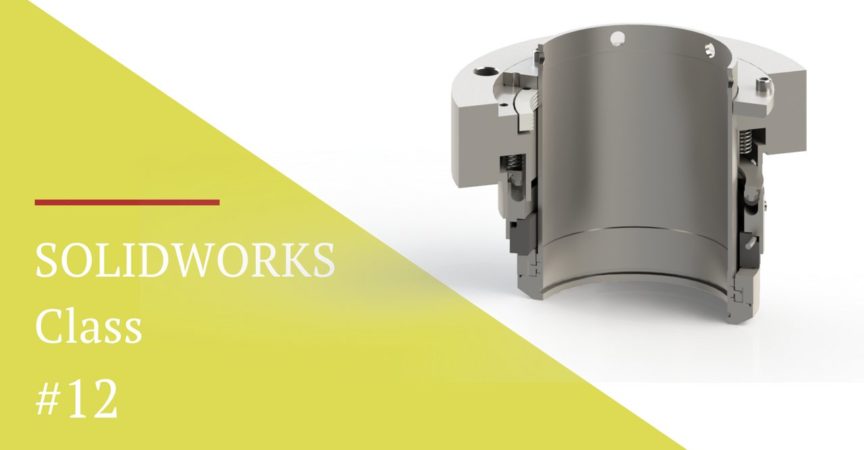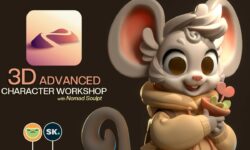TforDesign SOLIDWORKS Class Series
Release date:2017
Duration:09 h 22 m
Author:Tayseer Almattar
Skill level:Beginner
Language:English
Exercise files:Yes
Series Objective
The objective of this class series to take you from knowing nothing about SOLIDWORKS to having all the skills expected from a Certified SOLIDWORKS Associate and a Certified SOLIDWORKS Professional respectively.
This document contains the contents outline for TforDesign’s SOLIDWORKS Class Series as seen in SKILLSHARE. This document also contains the learning objective for each class.
High-level Classes Outline
Starting Point: I do not know anything about SOLIDWORKS
Class 1: Interface and Navigation
Class 2: SOLIDWORKS Sketching
Class 3: Basic Features 1
Class 4: Basic Features 2
Class 5: Materials and Mass Properties
Class 6: Basic Assemblies
Class 7: Drawings Basics
Mid-Point: I have all the skills expected from a Certified SOLIDWORKS Associate (CSWA)
Class 8: Advanced Features 1
Class 9: Advanced Features 2
Class 10: Design Tables and Configurations
Class 11: Assemblies Advanced Mates
Class 12: Assemblies Deep-Dive
Final-Point: I have all the skills expected from a Certified SOLIDWORKS Professional (CSWP)
Class 1: Interface and Navigation
– How to start a new part.
– What is represented in the command bar, canvas and design tree.
– How to select different measurement systems for your files.
– How to utilize the mouse through right clicks, zooming and rotating the model through the scroll wheel.
Class 2: SOLIDWORKS Sketching
– How to select a plane to sketch on.
– How to link your sketches to the origin.
– How to sketch basic shapes like lines, rectangles, circles, arcs, and ellipses.
– How to use dimensions to define your sketches.
– How to use relations to define your sketches.
– What are under-defined, fully-defined, and over-defined sketches.
– How does SOLIDWORKS apply relations automatically.
– How to know and delete active relations.
– What are construction and centre lines and how to utilize them.
– How to use the commands: mirror, offset, patterns, and trim.
Class 3: Basic Features 1
– What are features.
– What are the features Extrude Boss, Cut Extrude, Fillets and Chamfers.
– How to apply the features Extrude Boss, Cut Extrude, Fillets and Chamfers.
– How to edit existing features and sketches.
– How to delete existing features.
– What do you mean by Design Priorities?! and how could that affect our modelling.
Class 4: Basic Features 2
– What are the features Revolved boss and Revolved cut and how to apply them.
– What are the features Swept boss and Swept cut and how to apply them.
– What are the features lofted boss and lofted cut and how to apply them.
– What specifies a new reference plane.
– How to create new reference planes.
– How many planes are needed to apply sweep and loft features.
Class 5: Materials and Mass Properties
– How to apply materials to parts in SOLIDWORKS.
– How to find/view the properties of the materials in different units of measurement.
– How to find the mass properties for your parts.
– How to change the unit of measurement when viewing the mass properties.
Class 6: Basic Assemblies
– How to open an assembly file from nothing or from a part.
– What are the three types of mates in a SOLIDWORKS assembly: Standard, Advanced, Mechanical.
– Which part is fixed by default in an assembly.
– What are and how to use the standard mates: Coincident, Parallel, and Perpendicular.
– What are and how to use the standard mates: Tangent and Concentric.
– How to identify existing mates.
– How to delete and/or modify existing mates.
– What are and how to use the standard mates: Distance and Angle.
– What is and how to use the standard mate: LOCK.
Class 7: Drawings Basics
– How to open a drawings file from nothing or from a part.
– How to adjust the measurement units’ system in your drawing file.
– How to create standard Orthographic and Isometric views from a part.
– How to delete and add additional drawing views.
– How to adjust the drawing scale for your drawing views.
– How to communicate design information in your drawings using Smart Dimension, Hole Callout, and Centrelines.
– How to adjust the display style for a Drawing View.
– How to modify the information table at the bottom of a drawing file.
– How to export a drawing file into a PDF or an image.
– How to interpret: Auxiliary View, Section View, Detail View, Broken-out Section View and Crop View.
Class 8: Advanced Features 1
– What is the feature Draft and how to apply it.
– What is the feature Shell and how to apply it.
– What is the Hole Wizard and what is/are the wizard’s advantages
– How to set the hole specifications in the Hole Wizard.
– How to link more than one dimension to each other.
Class 9: Advanced Features 2
– What are equations, how to set them, and what are their advantages.
– What is feature mirroring and how to apply it.
– What are features end conditions and how to use them.
– What are multi-body parts, how to make them and what are their advantages.
– What is the difference between a multi-body part and an assembly.
– What is a feature scope, when can we use it and how.
– What is the feature rib and how to apply it.
Class 10: Design Tables and Configurations
– What are design tables and how to set them up.
– What are the advantages of using design tables.
– How to modify a design table.
– How to add variables to design tables.
– How to include suppressed and un-suppressed features in a design table.
– How to add configurations to an existing model.
Class 11: Assemblies Advanced Mates
– What is the advanced mate Profile Centre and how to apply it.
– What are the advanced mates Symmetric and width and how to apply them.
– How to set up a distance or an angular movement range.
– How to set movements to follow a certain path using Path mate.
– What is Linear/Linear Coupler mate and how to apply it.
Class 12: Assemblies Deep Dive
– How to link dimensions in different parts to each other using in-context features.
– What are Assembly Features and how to apply them.
– What is the design intent/message we give when using Assembly Features.
– How to detect and simulate collisions in an assembly.
– How to find out if two parts interfere with each other and by how much.
– How to replace a part in an assembly.
Class 1: Interface and Navigation
00 – Class Series Intro
01 – Intro to SW Interface and Navigation Class
02 – The Download Section
03 – Starting a new part
04 – The Command Bar Canvas and Design Tree
05 – Adjusting the Documents Measurements System
06 – Utilizing the Mouse for More Efficient Models Control and Creation
07 – Class Conclusion
08 – Teaser to Sketching and Project Intro
Class 2: SOLIDWORKS Sketching
00 – Class Series Intro
01 – Intro to Sketching
02 – The Download Section
03 – Select a Plane to Sketch on
04 – WATCH OUT Always link your sketches to the origin
05 – Sketching Rectangles and Lines
06 – Sketching Circles Arcs and Ellipses
07 – Using Dimensions to define sketches
08 – Using Angles to define sketches
09 – Using Relations to define your sketch between lines and points
10 – Using Relations to define your sketches Circles Ellipses and lines
11 – SOLIDWORKS applying relations automatically
12 – Knowing and Deleting Active Relations
13 – Construction and Center Lines
14 – Additional Commands Mirror Offset Patterns and Trim
15 – Student Projects
16 – Class Conclusion
17 – Teaser to the next Class Going 3D
Class 3: Basic Features 1
00 – Class Series Intro
01 – Intro to Basic Features 1
02 – The Download Section
03 – Extruded boss Cut Extrude and Fillet
04 – Editing and Deleting features
05 – Chamfers
06 – A point in Design Intent Design Priorities
07 – Group Exercise
08 – Student Projects
09 – Class Conclusion
Class 4: Basic Features 2
00 – Class Series Intro
01 – Intro to Basic Features 2
02 – The Download Section
03 – Revolved Boss and Revolved Cut
04 – Swept Boss and Swept Cut
05 – Reference Geometries Planes
06 – Lofted Boss and Lofted Cut
07 – Group Exercise
08 – Student Projects
09 – Class Conclusion
Class 5: Materials and Mass Properties
00 – Class Series Intro
01 – The Download Section
02 – Intro to materials and Mass Properties
03 – Selecting Mateirals for your Parts
04 – Viewing Mass Properties
05 – Student Project
06 – Class conclusion
Class 6: Basic Assemblies
00 – Class Series Intro
01 – Intro to Starting Assemblies
02 – The Download Section
03 – Opening an Assembly file
04 – Types of Mates in SW
05 – The base fixed part
06 – Standard mates Coincident Parallel and Perpendicular
07 – Standard Mates Tangent and Concentric
08 – Finding out existing mates deleting modifying them
09 – Standard Mates Distance and Angle
10 – Standard Mates Lock
11 – Reference Geometries Coordinate System
12 – Group Exercise
13 – Student Projects
14 – Class Conclusion
Class 7: Drawings Basics
00 – Class Series Intro
01 – Intro to Drawings Basics
02 – The Download Section
03 – Opening a Drawing File
04 – Adjusting measurements units system in a drawing file
05 – Creating Standard orthographic views
06 – Changing the drawing scale
07 – Communicate dimensions holes centerlines and display style
08 – Adjusting the information block at the bottom of the drawing
09 – Exporting a drawing as a PDF or an image
10 – Additional Drawing Competencies
11 – Group Exercise
12 – Student Projects
13 – Section conclusion
14 – Celebrating Accomplishment
Class 8: Advanced Features 1
00 – Class Series Intro
01 – Intro to Advanced Features 1
02 – The Download Section
03 – Draft
04 – Shell
05 – Hole Wizard
06 – Reference Geometries Coordinate System
07 – Linking Dimensions
08 – Group Exercise
09 – Student Projects
10 – Section Conclusion
Class 9: Advanced Features 2
00 – Class Series Intro
01 – Intro to Advanced Features 2
02 – The Download Section
03 – Equations
04 – Mirror
05 – Features End Conditions
06 – MultiBody Parts
07 – Features Scope
08 – Rib
09 – Group Exercise
10 – Student Projects
11 – Section Conclusion
Class 10: Design Tables and Configurations
00 – Class Series Intro
01 – Intro to Design Tables and Configurations
02 – The Download Section
03 – Establishing a Design Table
04 – Modifying an Established Design Table
05 – Configurations
06 – Group Exercise
07 – Student Projects
08 – Section Conclusion
Class 11: Assemblies Advanced Mates
00 – Class Series Intro
01 – Intro to Advanced Mates
02 – The Download Section
03 – Profile Center
04 – Symmetric and Width
05 – Distance and Angle Ranges
06 – Path Mate and LinearLinear Coupler
07 – Students Projects
08 – Section Conclusion
Class 12: Assemblies Deep-Dive
00 – Class Series Intro
01 – Intro to Assemblies Deep Dive
02 – The Download Section
03 – Assembly Features
04 – Collision and Interference Detection
05 – Replacing Parts in an Assembly
06 – SubAssemblies
07 – Student Project
08 – Section Conclusion
09 – Celebrating the accomplishment
AVC, 1280×720, 16:9, 30.000 fps, 320 Kbps ~ 2551 Kbps
AAC, 48.0 KHz, 64.0 Kbps, 2 channels





 Channel
Channel





